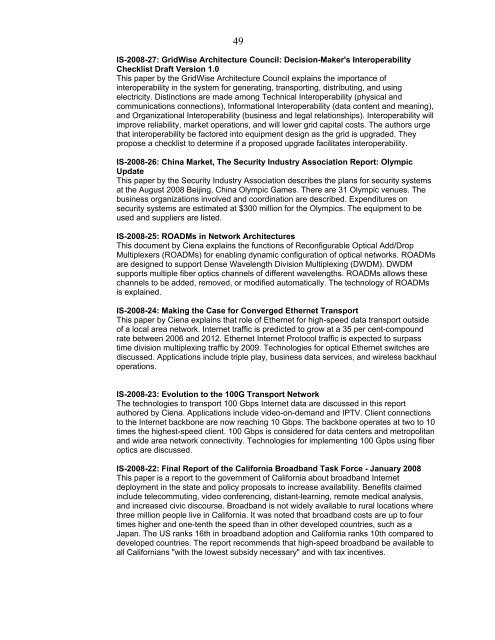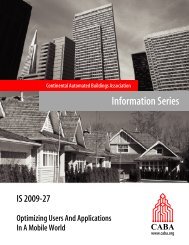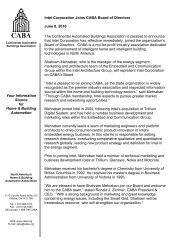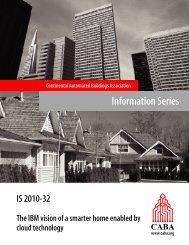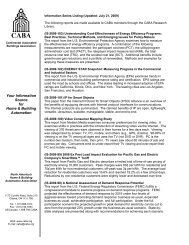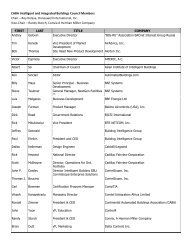Your Information Source for Home & Building Automation
Your Information Source for Home & Building Automation
Your Information Source for Home & Building Automation
You also want an ePaper? Increase the reach of your titles
YUMPU automatically turns print PDFs into web optimized ePapers that Google loves.
49<br />
IS-2008-27: GridWise Architecture Council: Decision-Maker's Interoperability<br />
Checklist Draft Version 1.0<br />
This paper by the GridWise Architecture Council explains the importance of<br />
interoperability in the system <strong>for</strong> generating, transporting, distributing, and using<br />
electricity. Distinctions are made among Technical Interoperability (physical and<br />
communications connections), <strong>In<strong>for</strong>mation</strong>al Interoperability (data content and meaning),<br />
and Organizational Interoperability (business and legal relationships). Interoperability will<br />
improve reliability, market operations, and will lower grid capital costs. The authors urge<br />
that interoperability be factored into equipment design as the grid is upgraded. They<br />
propose a checklist to determine if a proposed upgrade facilitates interoperability.<br />
IS-2008-26: China Market, The Security Industry Association Report: Olympic<br />
Update<br />
This paper by the Security Industry Association describes the plans <strong>for</strong> security systems<br />
at the August 2008 Beijing, China Olympic Games. There are 31 Olympic venues. The<br />
business organizations involved and coordination are described. Expenditures on<br />
security systems are estimated at $300 million <strong>for</strong> the Olympics. The equipment to be<br />
used and suppliers are listed.<br />
IS-2008-25: ROADMs in Network Architectures<br />
This document by Ciena explains the functions of Reconfigurable Optical Add/Drop<br />
Multiplexers (ROADMs) <strong>for</strong> enabling dynamic configuration of optical networks. ROADMs<br />
are designed to support Dense Wavelength Division Multiplexing (DWDM). DWDM<br />
supports multiple fiber optics channels of different wavelengths. ROADMs allows these<br />
channels to be added, removed, or modified automatically. The technology of ROADMs<br />
is explained.<br />
IS-2008-24: Making the Case <strong>for</strong> Converged Ethernet Transport<br />
This paper by Ciena explains that role of Ethernet <strong>for</strong> high-speed data transport outside<br />
of a local area network. Internet traffic is predicted to grow at a 35 per cent-compound<br />
rate between 2006 and 2012. Ethernet Internet Protocol traffic is expected to surpass<br />
time division multiplexing traffic by 2009. Technologies <strong>for</strong> optical Ethernet switches are<br />
discussed. Applications include triple play, business data services, and wireless backhaul<br />
operations.<br />
IS-2008-23: Evolution to the 100G Transport Network<br />
The technologies to transport 100 Gbps Internet data are discussed in this report<br />
authored by Ciena. Applications include video-on-demand and IPTV. Client connections<br />
to the Internet backbone are now reaching 10 Gbps. The backbone operates at two to 10<br />
times the highest-speed client. 100 Gbps is considered <strong>for</strong> data centers and metropolitan<br />
and wide area network connectivity. Technologies <strong>for</strong> implementing 100 Gpbs using fiber<br />
optics are discussed.<br />
IS-2008-22: Final Report of the Cali<strong>for</strong>nia Broadband Task Force - January 2008<br />
This paper is a report to the government of Cali<strong>for</strong>nia about broadband Internet<br />
deployment in the state and policy proposals to increase availability. Benefits claimed<br />
include telecommuting, video conferencing, distant-learning, remote medical analysis,<br />
and increased civic discourse. Broadband is not widely available to rural locations where<br />
three million people live in Cali<strong>for</strong>nia. It was noted that broadband costs are up to four<br />
times higher and one-tenth the speed than in other developed countries, such as a<br />
Japan. The US ranks 16th in broadband adoption and Cali<strong>for</strong>nia ranks 10th compared to<br />
developed countries. The report recommends that high-speed broadband be available to<br />
all Cali<strong>for</strong>nians "with the lowest subsidy necessary" and with tax incentives.


